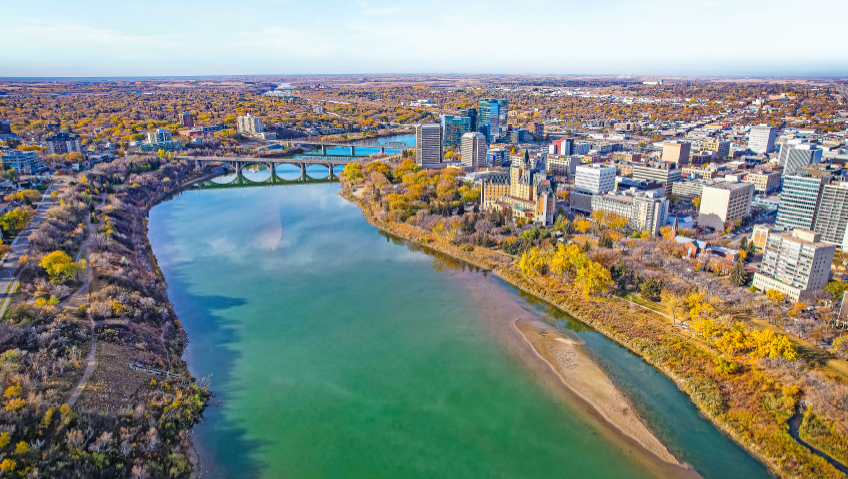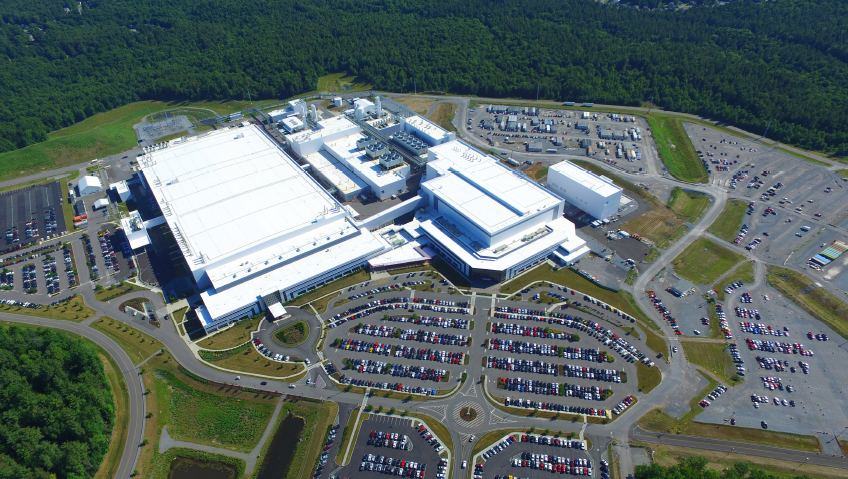Discussing the many advantages of living and working in Saskatoon, Erin Lawson says that for her, just one reason is the “three-song commute”—the length of time it takes to get just about anywhere in Saskatoon. With less time on the road commuting each day, you have more time to enjoy moments that matter, time for yourself, your family, and your community.
“It’s great having these short commute times, you get this sense of getting your time back,” says Lawson. Although she lives in Saskatoon’s far east side, getting to her job at the Saskatoon Regional Economic Development Authority (SREDA) in downtown Saskatoon takes only 10 minutes.
People, potential, and prosperity
A lifelong Saskatonian, Lawson first came to SREDA’s marketing and communications department in 2015, which she led for years before becoming the organization’s first female CEO last June.
What initially attracted her to SREDA almost a decade ago was the opportunity to work for an organization that could positively shape and contribute to the city she’d chosen to live and build her life in.
“The Saskatoon region has a lot to offer, and I am mindful of the opportunity we have here to tell the story of this community and the people who live and work in Saskatoon,” she says. “I love Saskatoon. It’s a great city, and I’m grateful to call it my home.”
SREDA is the economic development organization for the Saskatoon Region, and proudly supports the people, potential, and prosperity of Saskatoon and surrounding communities. Through intentional economic development services and initiatives, SREDA ensures a diverse, dynamic economy, helping businesses achieve strong, sustainable growth by providing pathways to success.
Advancing entrepreneurship, supporting Indigenous economic reconciliation, encouraging local business growth, and coordinating collaborative development provide abundant opportunities that will benefit the quality of life for residents and businesses of the region.
SREDA is an arm of the city, a non-profit primarily funded by the City of Saskatoon and industry partners. Through a variety of support programs, from investment attraction to growing businesses in the city and initiatives aimed at Indigenous economic reconciliation and development, SREDA focuses on four key sectors: agriculture, mining, manufacturing, and life sciences.
A region with everything
With almost 40 percent of the country’s entire farmland, Saskatchewan is fittingly known as ‘The Breadbasket of Canada.’ A combination of flat land, wide open spaces, and superior soil makes the province one of the world’s biggest exporters of canola and oilseeds, cereal grains and pulses, along with beef farming and feedlots, dairy and milk production, and much more.
“We are surrounded by natural resources and abundant farmland,” says Lawson. “We can proudly say that Saskatchewan, ‘feeds, fuels, and fertilizes the world.’”
The Saskatoon region is also home to some of the most advanced and prominent supporters of research and innovation in the Canadian agriculture sector, making for a unique ecosystem comprising some of the best and brightest minds working on global food security.
As well as agriculture, the Saskatoon region is famous for mining. Six minerals have been identified, including potash (used mainly in fertilizers), uranium, rare earth elements, helium, lithium, and copper. A world-renowned producer, Saskatchewan has attracted many leading mining companies, such as Nutrien, BHP, K+S, and others, bringing high-paying jobs to the regional economy. With a growing international focus on critical minerals, Saskatchewan is well-positioned for growth in the mining sector, including exploration and development.
“Mining has been a key part of our economy for years, so it is positive to see these developments in the industry,” says Lawson. “Through our work and key initiatives, our team will work to grow investment and business to this specific area.”
Today, manufacturing is another key economic driver, responsible for approximately 6.1 percent of the province’s GDP. This includes industries tied to agriculture—such as crop, food, and beverage processing—and leading-edge sectors like aerospace and defence, electronics, automotive, unmanned aerial vehicles (UAVs), and mining-related activity.
While some may not think of Saskatchewan as an innovation hub, the opposite is true, especially in life sciences, research, and biotechnology. With the province’s innovations in agriculture, health products, and nutraceuticals, Saskatchewan continues to attract leading companies in food sciences and food processing, animal sciences, medicine, and botany.
“Specifically in Saskatoon, we are unique in having this strong innovation hub,” says Lawson. “The focus on life sciences and biotechnology is seldom seen in other cities around the world, and we are fortunate to have these organizations that are unique to Canada.” These include Canadian Light Source (CLS), the country’s national synchrotron facility on the University of Saskatoon grounds, and Vaccine and Infectious Disease Organization (VIDO), Canada’s Centre for Pandemic Research.
These and other advanced institutions are housed in Innovation Place, near the University of Saskatchewan. “This makes for a unique mix, having traditional natural resources mixed in with research, development, and innovation. That is why we are seeing such a large growth in our population and city, because we are attracting talent from different regions, nationally and internationally.”
Building on success
The Saskatoon Regional Economic Development Authority continues to be part of many strategic initiatives and business incentives, including those centred on program development. This includes inbound hosting programs aimed at drawing international businesses to the city to explore offerings and build local connections. Business development initiatives such as tax abatement initiatives are focused on enabling businesses to attract new talent, facilitating investment, and long-term job creation. Efforts at a local level to support growth include assisting entrepreneurs.
And, with a significant Indigenous population, SREDA is proud to be behind SOAR, an Indigenous entrepreneurship support program. According to SREDA, “The number of Indigenous businesses in the Saskatoon region has almost doubled over the past decade, from 160 to 285, and spending by Indigenous business has nearly tripled in the last 10 years from $206 million (2011) to $608 million (2021).”
Through the SOAR kihiw paskîyâkêwin Indigenous Entrepreneurship Competition, presented by PIC Group, $25,000 in cash is awarded to promising Indigenous entrepreneurs poised for growth (https://sreda.com/what-we-do/soar-kihiw/).
“These types of programs have been our focus in the last few years, and will continue to be moving forward, with a highly strategic lens,” says Lawson. “Our goal is to support more Indigenous entrepreneurs, more local jobs, and investment to the region.”
SREDA is committed to building positive and meaningful relationships with Indigenous peoples, businesses, and communities. This means appropriate investment and participation in all aspects of its work.
“Economic reconciliation has the potential to be one of the most important economic growth opportunities in our province,” comments Lawson. “But it is important to note that there is still much work to be done to increase Indigenous participation in our economy and beyond.”
Expansion of the best kind
With considerable growth in recent years, the population of Saskatoon surpassed 300,000 last year, as thousands of new residents are being drawn to the city for reasons ranging from business opportunities to well-paying jobs, affordability to lifestyle.
For locals, the “three-song commute” not only means less stress getting places quickly, but more time for the things they enjoy, like the renowned art museum, Remai Modern, diverse restaurants and bars, conservation areas, farmers markets, and much more.
“The Saskatoon region isn’t just a great place to live; it is fast becoming one of the most attractive cities in Canada for business and investment expansion,” says Lawson. “Between our vibrant research and technology communities and advancements across our natural resources, we say Saskatoon is truly leading the way. And in terms of SREDA, we are here to support and connect businesses across all sectors, locally and internationally, and [help them meet] their expansion and growth needs. We have access to incentives and information, as well as a strong support network,” she says.
“One thing that’s nice about being a smaller city is we all know each other, and we can connect with key decision-makers in the city. We want to invite people to discover the benefits of living and working here.”






